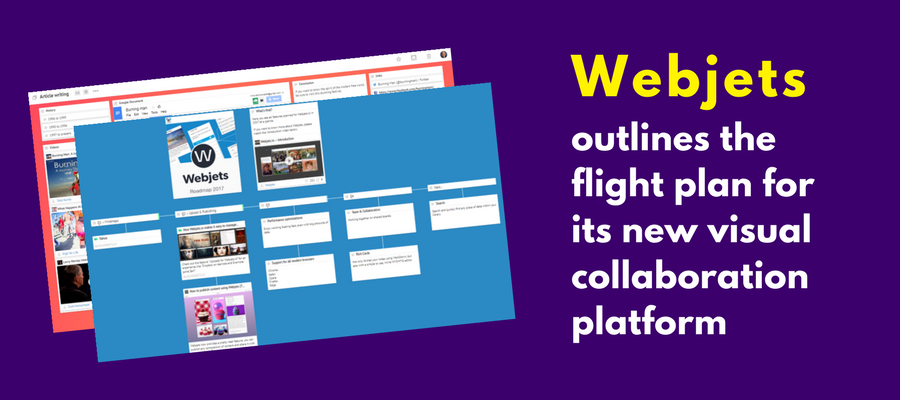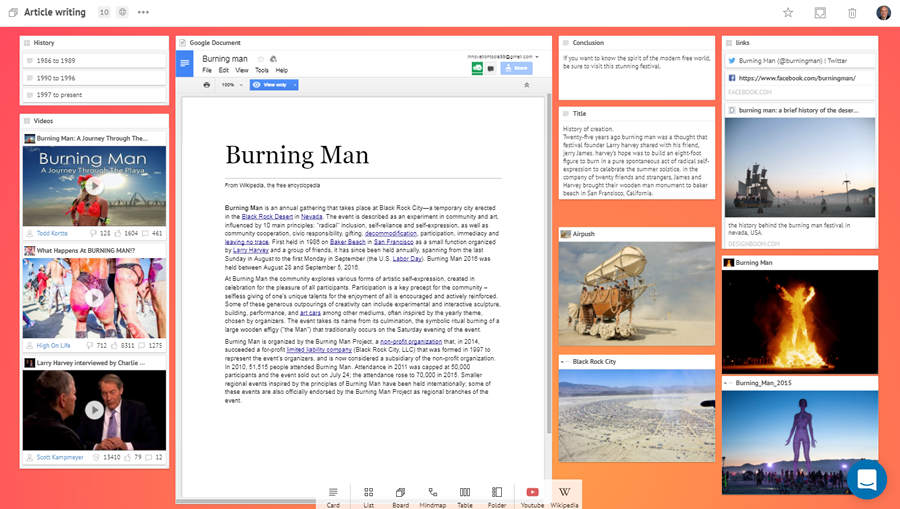Webjets is a web-based visual collaboration tool that is currently undergoing alpha testing. It uses a card metaphor to enable you to collect any kind of content quickly and easily and arrange them as needed to create workflows, moodboards and other visual collections of information.
Any content collected from the web can be added to Webjets, using drag and drop. You can even use IFTTT to push your data into the application. You can then organize and cluster it in a variety of ways, including lists, grids, mind maps, diagrams and tables.
I recently spoke with David Trattnig and Paul Savich, the founders of Webjets, to learn more about its origin story, the needs it’s designed to fill and what makes it unique compared to other visual collaboration tools.
Chuck Frey: What made you decide to create Webjets?
Paul Savich: We were avid users of countless productivity tools, bookmarking services and collaboration apps. The repeating outcome using traditional applications was:
- Fragmented data in multiple application silos
- Productivity loss due switching context between apps and different user interfaces
- Spending a lot of time gathering all that information spread across all those applications. And no simple way to keep the overview over all that knowledge
We had the deep demand for a single application, to capture and control all our data from within one interface. Think of a central control unit, as seen in the sci-fi movie Minority Report.
Frey: What needs does Webjets fill?
Savich: The need for more natural content, knowledge and project management. Think about sketching an idea – you can use Webjets to brainstorm its first aspects. You might take notes, collect YouTube videos on that topic and relate those things to each other.
As the idea evolves into an actual project, you don’t need to throw that initial sketch away. You just proceed with your project realization within the same environment e.g. by adding tasks and materials. This way Webjets enables users to keep the overview and control on all project data, over all project phases.
And it doesn’t matter how simple or advanced your projects are – users are free to invent their own structures and workflows.
Frey: What do you see as the primary use cases for Webjets? Who can benefit the most from it?
David Trattnig: Webjets is of great help for anybody who deals with information or works in the creative field. Whilst we are building an universal tool aiming for the average user who wants to organize knowledge (think Bookmarking or note taking), it also serves as a swiss-army knife for countless other use cases:
- Creativity – Designers, entrepreneurs, musicians, writers and bloggers
- Education – Teachers, students, coaches and visual thinkers
- Research – Scientists, analysts and students
- Teams – Managers, productivity users and remote workers
Imagine you want to write an article – you can take notes and collect source materials using cards in Webjets. The actual article can be written with e.g. Google Docs, which is deeply integrated to Webjets.
You may also think about teamwork – team members can individually manage their tasks and upload work materials. Then team boards can be created, allowing members to collaborate on brainstorming sessions or tasks in real-time.
Webjets provides the basis for most use cases and solves missing aspects by extensions and apps. Currently available apps are YouTube, Wikipedia, Atlassian JIRA and Confluence, Google Docs and Sheets. We plan to add many more applications and to provide an API for third-party app developers.
Frey: In what way is WebJets deeply integrated with Google Docs? And how is that integration reflected in a real use scenario, e.g., creating a rich outline in WebJets and then exporting it to Docs for the actual writing process?
Trattnig: Google Docs is integrated by having documents embedded directly in Webjets workspaces. This way you are allowed to capture notes and materials using Webjets, while writing on the actual document from within the same environment.
Frey: Why is the concept of cards so important? How does that make it easier for users to manage information?
Savich: Cards provide the power to reduce big amounts of information to its essence. They are small and versatile. That’s why sticky notes are so popular. We brought that concept to the digital sphere.
The technique of storing and relating notes using cards is based on a method known for hundreds of years. The famous German sociologist and thinker Niklas Luhmann has written countless books and articles, by referencing cards to each other in an analog form. Many creative people have structured their work using the Index Card Method before the age of computers.
In contrast to traditional sticky notes, Webjets allows unlimited amounts of dynamically nested and related cards. In times of users dealing with information overload, such concepts get more and more mainstream. Seeing a bunch of startups appearing in that field, support our expectation.
Here Webjets’ power lies within the ability to connected the dots of information in a 3 dimensional way:
- Create Mindmap relations on a board
- Create hierarchical relations by nesting cards infinitely
Frey: In the case of writers, the ability to display and edit Google Docs within the app seems to be unique. Sort of like Scrivener, except visual.
Savich: Exactly. Writers and content editors is only one group of users, Webjets is aiming for. Here we want to provide a seamless and fun experience of collecting and organizing information sources. Authors are able to for example review videos required for an article right from within the interface or make annotations on some text.
Frey: What does Webjets do that other web-based visual collaboration apps like Mural.ly, ConceptBoard and BoardThing don’t address?
Trattnig: There are indeed plenty of new visual collaboration apps out there. But all are either for very specific use cases like designing and sketching or don’t push the concept far enough beyond simple note-taking.
Webjets is aiming for a more universal approach to manage content:
- Cards can hold text but also interactive data dynamically retrieved from other websites. For example YouTube videos are natively integrated. Webjets provides an integration layer to allow native support for all your favorite Websites.
- Cards can be mini applications. For example we are currently testing a Atlassian JIRA integration for easily managing enterprise projects. At some point we also want to engage 3rd party developers to submit their own apps.
- Cards can be grouped and viewed in multiple ways, such as Boards, Tables, Lists and more to come.
In summary we want Webjets to not only be for sketching a project, but also be a tool which is used beyond the first stage. With Webjets you are able to transform brainstormed information into real project assets without switching tools. Because all your stuff is right at hand, in a single integrated toolchain.
Frey: A post on your Facebook page talks about the way in which you can “boost your cognitive process by staying focused within an universal environment.” What does that mean?
Trattnig: Cards placed on a board allow applying visual thinking, pattern recognition and clustering techniques. One such technique is the Method of Loci (better known as the Memory Palace technique of memorization) – through spatial positioning of information, the mind is able to quickly and efficiently recall big amounts of knowledge.
Others powers lie within the aforementioned types of visualizing your knowledge, depending on context. In certain cases where it’s more effective so display data in form of a list, in others a table might be the better choice.
Simply said, Webjets allows you to structure information in a similar way as the neural structures of your brain. It can be used as a companion for your mind.
Frey: On your Tumblog, it ssys: “Webjets allows pushing content into your inbox from any 3rd party service using IFTTT or WebHooks.” What types of things does this integration make possible? How are people using it?
Trattnig: The IFTTT feature allows users unlimited integrations with other services. You can set it up to automatically push your latest faved Feedly articles, upvoted YouTube videos or starred Gmail emails to your Webjets Inbox. Just to name a few.
Using IFTTT you are able to connect almost any web service with Webjets.
Frey: What is the function of the WebJets inbox?
Trattnig: The “inbox concept” is popularized by the Getting Things Done (GTD) workflow by David Allen. The idea is to collect any content in a global inbox – a place where you can quickly store things without further thinking.
The next step is to sort that stuff in you inbox into specific project folders. This is done after defined review cycles or whenever it matches your schedule.
In Webjets the inbox acts as a container for adding things manually, but also any data pushed to your workplace from the outside world, similar to your Email inbox:
- Cards shared by other users
- Information collected with the Bookmarklet or Browser Extension
- Any 3rd party integrations sharing things (e.g. IFTTT)
Frey: Is the Bookmarklet & Browser Extension available yet? If not, ETA?
Trattnig: The bookmarklet is already available. Just drag it from within the Webjets settings to your bookmarks bar. Then, whenever you click on it, the current website is instantly stored in your Webjets inbox.
The browser extension is in experimental state, hence a release date cannot be provided yet.
Frey: What’s the difference between a canvas, a board and a folder?
Trattnig: A board is a space where cards can freely be placed. Similar to windows on the desktop, known from traditional operating systems.
Canvas is the deprecated term for a board.
A folder is similar to a list, additionally giving you a preview of the selected item on the right side (Master-detail concept).
Frey: What’s a “navigator?”
Trattnig: This is a deprecated term for the folder.
Frey: Do you plan to integrate with any developers of mind mapping software – to enable users to export a mind map created in one of those software programs and import it into Webjets?
Savich: Yes, we’re planning to add support of OPML format which is a standard for mind-mapping and outline processors.
Frey: Webjets is still in the alpha stage of development. How do you expect it to evolve as you get user input?
Savich: We’re currently working on performance and UX improvements, based on the feedback collected from our alpha users.
The next major features on our roadmap are real-time collaboration, rich text for notes (currently markdown is supported), and native apps for Mac, iOS and Android. You can also check our Roadmap for 2017.
Frey: What else should the readers of my blog know about Webjets?
Savich: Even though we are currently labeling our product “Alpha”, we want to emphasize that it’s stable enough for productive use.
We appreciate any kind of feedback and are eager to see users help shaping the product. Let’s make a great product together!
It’s also worth mentioning that the 50 most active users will receive a free, lifetime pro-account. Still, the standard account will stay free forever.
Frey: Where is the best place for my readers to go to learn about the thinking behind Webjets?
Savich: Currently the main resources to learn about the ideas behind Webjets are our Tumblr and Medium Blogs.
We are in the process of adding a learning section to our website, which will be a growing library for learning resources. Just give webjets.io/learn a try in the coming weeks.





Leave a Reply